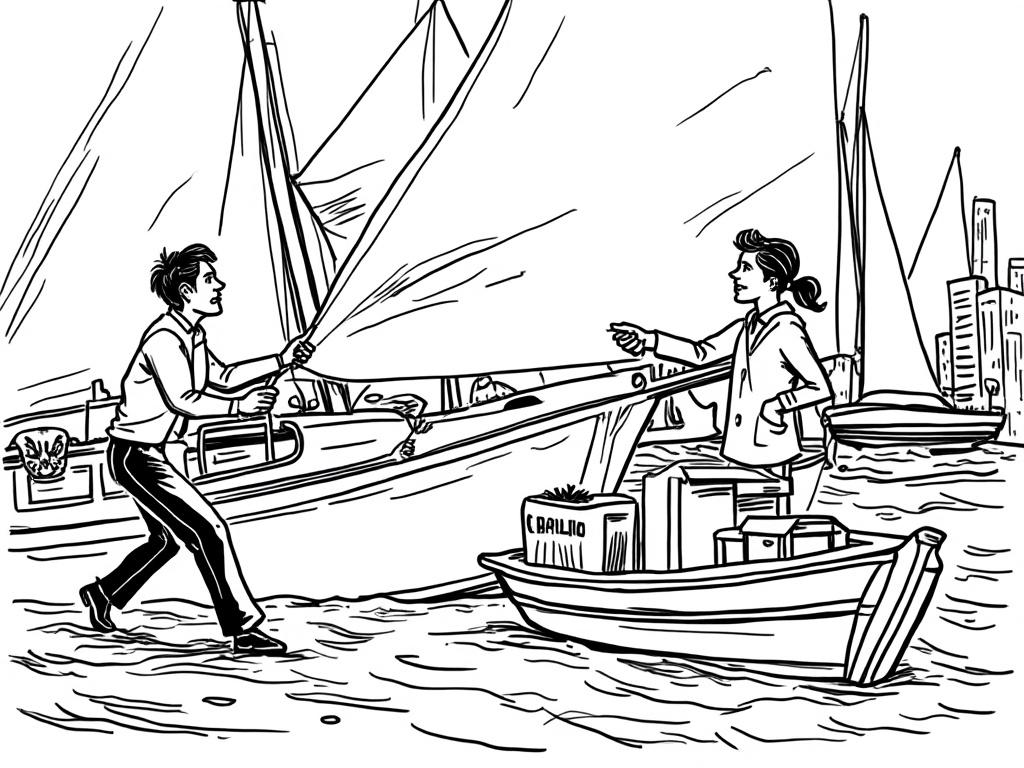
Sailing and Maritime Sports in Greece: Your Complete Guide to Blue Water Adventures
Reading time: 12 minutes
Table of Contents
- Why Greece Rules the Maritime Sports World
- Top Sailing Destinations and Hidden Gems
- Beyond Sailing: Maritime Sports Spectrum
- Getting Started: Your Practical Roadmap
- Navigating Common Challenges
- Greek Islands Maritime Sports Comparison
- Charting Your Maritime Adventure Path
- Frequently Asked Questions
Why Greece Rules the Maritime Sports World
Ever wondered why Greece consistently ranks among the world’s top sailing destinations? The answer lies in a perfect storm of geography, culture, and maritime heritage that creates an unparalleled playground for water sports enthusiasts.
Picture this: 6,000 islands and islets scattered across crystal-clear waters, with only 227 inhabited. That’s roughly 16,000 kilometers of coastline offering everything from sheltered bays perfect for beginners to challenging open-water routes that test seasoned sailors. But here’s what most guides won’t tell you—it’s not just about the numbers.
Quick Reality Check: While Instagram might show you pristine, empty waters, the reality is more nuanced. Peak season (July-August) brings crowds, but strategic timing and local knowledge unlock Greece’s maritime secrets.
The Greek maritime sports scene operates on three fundamental pillars:
- Accessibility: Multiple skill levels accommodated across diverse locations
- Infrastructure: Well-developed marina networks and support services
- Cultural Integration: Maritime activities woven into local lifestyle and economy
Top Sailing Destinations and Hidden Gems
The Cyclades: Where Sailing Dreams Come Alive
The Cyclades archipelago represents Greece’s sailing crown jewel, but success here requires strategic planning. Mykonos and Santorini grab headlines, yet experienced sailors often prefer the “back islands” like Folegandros or Sikinos for authentic experiences.
Case Study: Sarah Mitchell, a British sailing instructor with 15 years of Mediterranean experience, explains: “The Cyclades teach you everything about sailing. You’ll encounter the Meltemi winds—consistently strong northerlies that can reach 25-30 knots. It’s challenging but predictable, making it perfect for skill development.”
The Meltemi wind system defines Cycladic sailing from June through September. These thermal winds create:
- Morning calms (6-10 AM): Perfect for harbor departures
- Afternoon intensity (1-6 PM): Experienced sailor territory
- Evening moderation: Ideal for approach and anchoring
Ionian Islands: The Gentle Giant
If the Cyclades are Greece’s sailing university, the Ionian Islands serve as the welcoming elementary school. Corfu, Kefalonia, and Zakynthos offer milder conditions with consistent but manageable winds averaging 10-15 knots.
The Ionian’s secret weapon? Accessibility for land-based accommodation. Many sailing enthusiasts choose to base themselves in flats for sale in greece and day-sail, creating a lifestyle that blends maritime adventure with stable accommodation—a strategy gaining popularity among digital nomads and retirees.
Dodecanese: Advanced Sailor’s Playground
The Dodecanese chain offers Greece’s most diverse sailing conditions. Rhodes serves as the operational hub, while islands like Symi and Kastellorizo provide intimate harbors and challenging navigation opportunities.
Pro Tip: The Dodecanese season extends longer than other regions. October and November sailing here offers warm temperatures with fewer crowds—just monitor weather systems more carefully.
Beyond Sailing: Maritime Sports Spectrum
Competitive Sailing and Regattas
Greece hosts over 50 organized regattas annually, from international competitions to local club races. The Aegean Rally and Cyclades Regatta draw international fleets, while smaller events like the Spetses Classic Yacht Regatta focus on traditional vessels.
Participation Strategy:
- Start with local club events in Athens or Thessaloniki
- Progress to island-based regattas (less competitive pressure)
- Consider crewing opportunities on established boats
- Build experience before entering major international events
Windsurfing and Kitesurfing Hotspots
Paros and Naxos dominate Greece’s windsurfing scene, with consistent winds and professional instruction centers. Prasonisi Beach in Rhodes offers unique conditions where two seas meet, creating varied wind patterns perfect for advanced practitioners.
The Greek windsurfing industry supports approximately 12,000 jobs directly, with equipment rental, instruction, and related services generating €180 million annually according to the Hellenic Windsurfing Association.
Diving and Underwater Sports
Greek waters hide remarkable underwater landscapes, though regulations require attention. Licensed diving centers operate in most tourist areas, with Crete and the Ionian Islands offering the most diverse underwater experiences.
Regulatory Note: Diving in Greek waters requires permits in certain areas, particularly around archaeological sites. Always dive with licensed operators who handle permissions.
Getting Started: Your Practical Roadmap
Licensing and Certification Requirements
Greece recognizes most international sailing certifications, but specific requirements apply:
For Sailing:
- RYA Day Skipper or equivalent for boats under 12 meters
- ICC (International Certificate of Competence) recommended
- VHF Radio Operator’s Certificate required for radio use
Charter Company Reality: Most operators accept basic certifications but may require additional checks or skippered options for inexperienced sailors. Budget extra for potential skipper fees (€150-200 daily).
Seasonal Planning and Weather Patterns
Strategic timing transforms your Greek maritime experience:
Peak Season (July-August):
- Advantages: Reliable weather, full services, vibrant atmosphere
- Challenges: Crowds, higher prices, limited spontaneous bookings
Shoulder Seasons (May-June, September-October):
- Advantages: Moderate crowds, better prices, pleasant temperatures
- Considerations: Some services may have limited hours
Equipment and Charter Options
The Greek charter market offers extensive options, but smart selection requires understanding hidden costs:
Bareboat Charter Costs (Weekly, High Season):
- 35-foot sailing yacht: €1,800-2,500
- 40-foot sailing yacht: €2,500-3,500
- 45-foot sailing yacht: €3,500-5,000
Hidden Cost Alert: Add 30-40% for extras including fuel, cleaning, insurance excesses, and provisions.
Navigating Common Challenges
Challenge 1: Meltemi Wind Management
The Meltemi winds catch unprepared sailors off-guard, creating safety concerns and schedule disruptions.
Solution Strategy:
- Plan shorter daily distances during Meltemi season
- Identify alternative harbors for each planned stop
- Monitor wind forecasting apps (Windy, PredictWind) multiple times daily
- Master anchoring techniques for crowded bays
Real Example: Captain Andreas Papadopoulos, who runs sailing courses in the Cyclades, shares: “I teach sailors to plan three routes daily—optimistic, realistic, and conservative. The Meltemi demands flexibility, not rigid schedules.”
Challenge 2: Harbor and Mooring Availability
Popular destinations experience harbor congestion, particularly during peak season and local festivals.
Advanced Booking Strategy:
- Reserve marinas in advance for key destinations (Mykonos, Santorini, Hydra)
- Develop anchoring skills for bay stays
- Research lesser-known harbors as backup options
- Consider mid-week arrivals to avoid weekend crowding
Challenge 3: Cultural Navigation and Local Customs
Understanding Greek maritime culture improves both safety and enjoyment.
Cultural Integration Tips:
- Learn basic Greek phrases for harbor interactions
- Respect local fishing activities and traditional boat traffic
- Understand siesta timing (2-5 PM) affects service availability
- Participate in local maritime festivals when possible
Greek Islands Maritime Sports Comparison
| Island Group | Wind Conditions | Skill Level | Season Length | Marina Infrastructure |
|---|---|---|---|---|
| Cyclades | Strong, Consistent | Intermediate-Advanced | May-October | Excellent |
| Ionian | Moderate, Predictable | Beginner-Intermediate | April-November | Very Good |
| Dodecanese | Variable, Challenging | Intermediate-Advanced | April-November | Good |
| Saronic Gulf | Light-Moderate | All Levels | March-November | Excellent |
| Northern Aegean | Strong, Variable | Advanced | May-September | Moderate |
Maritime Sports Participation Rates by Region
Annual Visitor Participation (in thousands)
Charting Your Maritime Adventure Path
Ready to transform from maritime dreamer to confident Greek waters navigator? Your success depends on strategic preparation, not just enthusiasm. Here’s your actionable roadmap:
Immediate Next Steps (This Month):
- Skill Assessment: Honestly evaluate your current abilities and book refresher courses if needed
- Certification Update: Ensure your sailing credentials meet Greek charter requirements
- Route Research: Study three potential sailing areas matching your skill level
- Weather Pattern Study: Download Greek-specific weather apps and practice interpretation
Three-Month Preparation Phase:
- Physical Conditioning: Build sailing-specific fitness, particularly core strength and endurance
- Language Basics: Learn essential Greek maritime vocabulary and emergency phrases
- Network Building: Connect with local sailing clubs and online Greek sailing communities
- Equipment Familiarization: Practice with Greek chart systems and navigation aids
Long-term Mastery Strategy:
Consider the growing trend of sailing lifestyle integration—many maritime enthusiasts now blend extended sailing seasons with strategic property investments in Greek coastal areas. This approach provides operational bases while building equity in one of Europe’s most promising maritime tourism markets.
The future of Greek maritime sports looks exceptionally bright. Infrastructure investments totaling €2.3 billion through 2027 will expand marina capacity by 40%, while sustainable tourism initiatives promise to preserve the pristine waters that make Greece special.
Your next decision shapes everything: Will you join the ranks of confident sailors who’ve mastered Greek waters, or remain a wistful observer watching others live their maritime dreams? The winds are favorable, the waters are calling, and your adventure awaits strategic action.
Frequently Asked Questions
What’s the minimum sailing experience needed to charter safely in Greek waters?
Most charter companies require at least RYA Day Skipper certification or equivalent, plus demonstrated experience in similar conditions. However, the Ionian Islands welcome less experienced sailors with basic certification, while the Cyclades demand intermediate skills due to stronger wind conditions. Consider starting with skippered charters to build confidence and local knowledge before progressing to bareboat charters.
How much should I budget for a week-long sailing vacation in Greece?
Budget €2,500-4,000 per week for a group of 4-6 people, including charter fees, fuel, provisions, and marina costs. This breaks down to approximately €1,500-2,500 for boat charter, €300-500 for fuel, €400-600 for food and supplies, and €300-400 for marina fees and miscellaneous expenses. Shoulder season sailing can reduce costs by 20-30%.
When is the best time to avoid crowds while still having good sailing conditions?
Late May through mid-June and September through early October offer the optimal balance of good weather, manageable crowds, and reasonable prices. May provides fresh spring conditions with limited crowds, while September delivers warm water temperatures as tourist numbers decline. Avoid July-August unless you embrace the festive atmosphere and don’t mind premium pricing and crowded anchorages.

Article reviewed by Isabella Fontaine, Alpine Luxury Properties | Discreet High-Altitude Investments, on June 6, 2025
